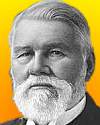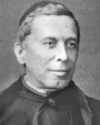 | TODAY IN SCIENCE HISTORY NEWSLETTER - 26 FEBRUARY |
| Feature for Today |
 On 26 Feb 1870, Alfred Ely Beach (publisher of the Scientific American magazine) opened New York City's first pneumatic-powered subway. It was only one block long, being an experimental project. On 26 Feb 1870, Alfred Ely Beach (publisher of the Scientific American magazine) opened New York City's first pneumatic-powered subway. It was only one block long, being an experimental project.Subways in that era would have a major problem with the conventional power of steam locomotives - smoke! Hence the investigation of a pneumatic tube to move the passenger carriage. You can read about the event in a 1870 newspaper article announcing the opening of The Broadway Tunnel.  |
| Book of the Day | |
| |
| Quotations for Today | |
 | "Always preoccupied with his profound researches, the great Newton showed in the ordinary-affairs of life an absence of mind which has become proverbial. It is related that one day, wishing to find the number of seconds necessary for the boiling of an egg, he perceived, after waiting a minute, that he held the egg in his hand, and had placed his seconds watch (an instrument of great value on account of its mathematical precision) to boil! This absence of mind reminds one of the mathematician Ampere, who one day, as he was going to his course of lectures, noticed a little pebble on the road; he picked it up, and examined with admiration the mottled veins. All at once the lecture which he ought to be attending to returned to his mind; he drew out his watch; perceiving that the hour approached, he hastily doubled his pace, carefully placed the pebble in his pocket, and threw his watch over the parapet of the Pont des Arts. " |
 | "Every day, and in every way, I am becoming better and better." - �mile Cou�, French pharmacist and advocate of optimistic autosuggestion (born 26 Feb 1857) |
 | "It occurred to me that if I could invent a machine - a gun - which could by its rapidity of fire, enable one man to do as much battle duty as a hundred, that it would, to a large extent supersede the necessity of large armies, and consequently, exposure to battle and disease [would] be greatly diminished." |
| QUIZ | |
| Before you look at today's web page, see if you can answer some of these questions about the events that happened on this day. Some of the names are very familiar. Others will likely stump you. Tickle your curiosity with these questions, then check your answers on today's web page. | |
| Births | |
 |  John Evershed, born 26 Feb 1864, was an English astronomer who discovered (1909) the Evershed effect. While photographing solar prominences and sunspot spectra, he noticed that many of the Fraunhofer lines in the sunspot spectra were shifted to the red. By showing that these were Doppler shifts, he proved they were due to a motion. John Evershed, born 26 Feb 1864, was an English astronomer who discovered (1909) the Evershed effect. While photographing solar prominences and sunspot spectra, he noticed that many of the Fraunhofer lines in the sunspot spectra were shifted to the red. By showing that these were Doppler shifts, he proved they were due to a motion.  What motion related to sunspots had he discovered? What motion related to sunspots had he discovered? |
 |  An inventor, born 26 Feb 1829, was one of the best-known beneficiaries of California's gold rush economic boom. He was born in Bavaria and trained as a tailor. One of thousands, he travelled to San Francisco in 1850, hoping to make his fortune. His original plan was to manufacture tents and wagon covers, but instead found a market using the stout canvas he had brought with him to make very durable pants for the Forty-niners. Finding that these pants sold as fast as he could make them, he opened a factory, improved the design by adding copper rivets at the stress points in his pants, and adopted a heavy blue denim material. An inventor, born 26 Feb 1829, was one of the best-known beneficiaries of California's gold rush economic boom. He was born in Bavaria and trained as a tailor. One of thousands, he travelled to San Francisco in 1850, hoping to make his fortune. His original plan was to manufacture tents and wagon covers, but instead found a market using the stout canvas he had brought with him to make very durable pants for the Forty-niners. Finding that these pants sold as fast as he could make them, he opened a factory, improved the design by adding copper rivets at the stress points in his pants, and adopted a heavy blue denim material.  Can you name this inventor? Can you name this inventor? |
| Deaths | |
 |  Pietro Angelo Secchi (1818-1878) was an Italian Jesuit priest and astrophysicist, who studied the dark lines which join the two hemispheres of Mars. Beyond astronomy, his interests ranged from archaeology to geodesy, from geophysics to meteorology. Pietro Angelo Secchi (1818-1878) was an Italian Jesuit priest and astrophysicist, who studied the dark lines which join the two hemispheres of Mars. Beyond astronomy, his interests ranged from archaeology to geodesy, from geophysics to meteorology. |
| Events | |
 |  On 26 Feb of a certain year, radar (RAdio Detection And Ranging) was first demonstrated in England by Robert Watson-Watt at Daventry. He was a Scottish physicist, who had been working on methods of using radio-wave detection to locate thunderstorms in order to provide warnings to airmen. On 26 Feb of a certain year, radar (RAdio Detection And Ranging) was first demonstrated in England by Robert Watson-Watt at Daventry. He was a Scottish physicist, who had been working on methods of using radio-wave detection to locate thunderstorms in order to provide warnings to airmen.  In which decade was this first demonstration of radar? In which decade was this first demonstration of radar? |
 |  On 26 Feb 1896, Henri Becquerel stored a phosphorescent compound in a closed desk drawer on top of a photographic plate awaiting a sunnier day to test his idea that sunlight would make the material emit rays. It remained there several days. Thus by accident, he created a new experiment, for when he developed the photographic plate, he found a fogged image in the shape of the rocks. The material was spontaneously generating and emitting the energetic rays totally without the external sunlight source. On 26 Feb 1896, Henri Becquerel stored a phosphorescent compound in a closed desk drawer on top of a photographic plate awaiting a sunnier day to test his idea that sunlight would make the material emit rays. It remained there several days. Thus by accident, he created a new experiment, for when he developed the photographic plate, he found a fogged image in the shape of the rocks. The material was spontaneously generating and emitting the energetic rays totally without the external sunlight source.  What element was in the compound that caused this effect on the photographic plate? What element was in the compound that caused this effect on the photographic plate? |
| Answers |
When you have your answers ready to all the questions above, you'll find all the information to check them, and more, on the February 26 web page of Today in Science History. Or, try this link first for just the brief answers. Fast answers for the previous newsletter for February 25: the Rhine River; the actinides; infrared; the decade including the year 1837; Galileo. |
| Feedback |
 If you enjoy this newsletter, the website, or wish to offer encouragement or ideas, please send feedback by using your mail reader Reply button. If you enjoy this newsletter, the website, or wish to offer encouragement or ideas, please send feedback by using your mail reader Reply button. |
--
If you do not want to receive any more newsletters, Unsubscribe
To update your preferences and to unsubscribe visit this link


Δεν υπάρχουν σχόλια:
Δημοσίευση σχολίου